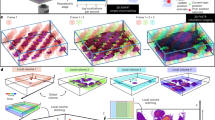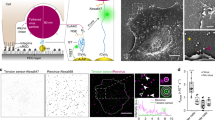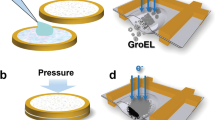Abstract
A detailed understanding of the cellular uptake process is essential to the development of cellular delivery strategies1 and to the study of viral trafficking2. However, visualization of the entire process, encompassing the fast dynamics (local to the freely diffusing nanoparticle) as well the state of the larger-scale cellular environment, remains challenging3. Here, we introduce a three-dimensional multi-resolution method to capture, in real time, the transient events leading to cellular binding and uptake of peptide (HIV1-Tat)-modified nanoparticles. Applying this new method to observe the landing of nanoparticles on the cellular contour in three dimensions revealed long-range deceleration of the delivery particle, possibly due to interactions with cellular receptors. Furthermore, by using the nanoparticle as a nanoscale ‘dynamics pen’, we discovered an unexpected correlation between small membrane terrain structures and local nanoparticle dynamics. This approach could help to reveal the hidden mechanistic steps in a variety of multiscale processes.
This is a preview of subscription content, access via your institution
Access options
Subscribe to this journal
Receive 12 print issues and online access
$259.00 per year
only $21.58 per issue
Buy this article
- Purchase on Springer Link
- Instant access to full article PDF
Prices may be subject to local taxes which are calculated during checkout




Similar content being viewed by others
References
Petros, R. A. & DeSimone, J. M. Strategies in the design of nanoparticles for therapeutic applications. Nature Rev. Drug Discov. 9, 615–627 (2010).
Flint, S. J., Enquist, L. W., Racaniello, V. R. & Skalka, A. M. Principles of Virology Vol. 1 (American Society for Microbiology, 2009).
Sun, E., He, J. & Zhuang, X. Live cell imaging of viral entry. Curr. Opin. Virol. 3, 34–43 (2013).
Zauner, W., Farrow, N. A. & Haines, A. M. R. In vitro uptake of polystyrene microspheres: effect of particle size, cell line and cell density. J. Control. Rel. 71, 39–51 (2001).
Geng, Y. et al. Shape effects of filaments versus spherical particles in flow and drug delivery. Nature Nanotech. 2, 249–255 (2007).
Doherty, G. J. & McMahon, H. T. Mechanisms of endocytosis. Annu. Rev. Biochem. 78, 857–902 (2009).
Katayama, Y. et al. Real-time nanomicroscopy via three-dimensional single-particle tracking. ChemPhysChem 10, 2458–2464 (2009).
Ruthardt, N., Lamb, D. C. & Brauchle, C. Single-particle tracking as a quantitative microscopy-based approach to unravel cell entry mechanisms of viruses and pharmaceutical nanoparticles. Mol. Ther. 19, 1199–1211 (2011).
Müller, B. & Heilemann, M. Shedding new light on viruses: super-resolution microscopy for studying human immunodeficiency virus. Trends Microbiol. 21, 522–533 (2013).
Liu, B. R., Huang, Y-w., Winiarz, J. G., Chiang, H-J. & Lee, H-J. Intracellular delivery of quantum dots mediated by a histidine- and arginine-rich HR9 cell-penetrating peptide through the direct membrane translocation mechanism. Biomaterials 32, 3520–3537 (2011).
Pelkmans, L., Kartenbeck, J. & Helenius, A. Caveolar endocytosis of simian virus 40 reveals a new two-step vesicular-transport pathway to the ER. Nature Cell Biol. 3, 473–483 (2001).
Eiriksdottir, E., Mager, I., Lehto, T., El Andaloussi, S. & Langel, U. Cellular internalization kinetics of (luciferin-)cell-penetrating peptide conjugates. Bioconj. Chem. 21, 1662–1672 (2010).
Barrow, E., Nicola, A. & Liu, J. Multiscale perspectives of virus entry via endocytosis. Virol. J. 10, 177 (2013).
Vives, E., Brodin, P. & Lebleu, B. A truncated HIV-1 Tat protein basic domain rapidly translocates through the plasma membrane and accumulates in the cell nucleus. J. Biol. Chem. 272, 16010–16017 (1997).
Lewin, M. et al. Tat peptide-derivatized magnetic nanoparticles allow in vivo tracking and recovery of progenitor cells. Nature Biotechnol. 18, 410–414 (2000).
Tyagi, M., Rusnati, M., Presta, M. & Giacca, M. Internalization of HIV-1 Tat requires cell surface heparan sulfate proteoglycans. J. Biol. Chem. 276, 3254–3261 (2001).
Gentile, M. et al. Determination of the size of HIV using adenovirus type 2 as an internal length marker. J. Virol. Methods 48, 43–52 (1994).
Hewlett, L., Prescott, A. & Watts, C. The coated pit and macropinocytic pathways serve distinct endosome populations. J. Cell Biol. 124, 689–703 (1994).
Fuchs, S. M. & Raines, R. T. Pathway for polyarginine entry into mammalian cells. Biochemistry 43, 2438–2444 (2004).
Cang, H., Xu, C. S., Montiel, D. & Yang, H. Guiding a confocal microscope by single fluorescent nanoparticles. Opt. Lett. 32, 2729–2731 (2007).
Cang, H., Wong, C. M., Xu, C. S., Rizvi, A. H. & Yang, H. Confocal three dimensional tracking of a single nanoparticle with concurrent spectroscopic readouts. Appl. Phys. Lett. 88, 223901 (2006).
Cang, H., Montiel, D., Xu, C. S. & Yang, H. Observation of spectral anisotropy of gold nanoparticles. J. Chem. Phys. 129, 044503 (2008).
Montiel, D., Cang, H. & Yang, H. Quantitative characterization of changes in dynamical behavior for single-particle tracking studies. J. Phys. Chem. B 110, 19763–19770 (2006).
Brenner, H. The slow motion of a sphere through a viscous fluid towards a plane surface. Chem. Eng. Sci. 16, 242–251 (1961).
Lin, B., Yu, J. & Rice, S. A. Direct measurements of constrained Brownian motion of an isolated sphere between two walls. Phys. Rev. E 62, 3909–3919 (2000).
Schmidt, N., Mishra, A., Lai, G. H. & Wong, G. C. L. Arginine-rich cell-penetrating peptides. FEBS Lett. 584, 1806–1813 (2010).
Mattila, P. K. & Lappalainen, P. Filopodia: molecular architecture and cellular functions. Nature Rev. Mol. Cell Biol. 9, 446–454 (2008).
Lehmann, M. J., Sherer, N. M., Marks, C. B., Pypaert, M. & Mothes, W. Actin- and myosin-driven movement of viruses along filopodia precedes their entry into cells. J. Cell Biol. 170, 317–325 (2005).
Sherer, N. M. et al. Retroviruses can establish filopodial bridges for efficient cell-to-cell transmission. Nature Cell Biol. 9, 310–315 (2007).
Aggarwal, A. et al. Mobilization of HIV spread by diaphanous 2 dependent filopodia in infected dendritic cells. PLoS Pathogens 8, e1002762 (2012).
Acknowledgements
The authors thank S. McManus for assistance with TEM measurements. This work was supported by the US Department of Energy (DE-SC0006838) and by Princeton University.
Author information
Authors and Affiliations
Contributions
K.W. and H.Y. conceived and designed the experiments. K.W. performed the experiments. K.W. and H.Y. analysed the data. K.W. and H.Y. wrote the paper.
Corresponding author
Ethics declarations
Competing interests
The authors declare no competing financial interests.
Supplementary information
Supplementary information
Supplementary Information (PDF 7744 kb)
Supplementary movie 1
Supplementary movie 1 (MP4 24503 kb)
Supplementary movie 2
Supplementary movie 2 (MP4 7423 kb)
Supplementary movie 3
Supplementary movie 3 (MP4 1702 kb)
Supplementary movie 4
Supplementary movie 4 (MP4 24156 kb)
Supplementary movie 5
Supplementary movie 5 (MP4 3753 kb)
Supplementary movie 6
Supplementary movie 6 (MP4 24136 kb)
Supplementary movie 4
Supplementary movie 4 (MP4 2170 kb)
Supplementary movie 5
Supplementary movie 5 (MP4 881 kb)
Supplementary movie 6
Supplementary movie 6 (MP4 16106 kb)
Rights and permissions
About this article
Cite this article
Welsher, K., Yang, H. Multi-resolution 3D visualization of the early stages of cellular uptake of peptide-coated nanoparticles. Nature Nanotech 9, 198–203 (2014). https://doi.org/10.1038/nnano.2014.12
Received:
Accepted:
Published:
Issue Date:
DOI: https://doi.org/10.1038/nnano.2014.12
This article is cited by
-
Capturing the start point of the virus–cell interaction with high-speed 3D single-virus tracking
Nature Methods (2022)
-
Modular fluorescent nanoparticle DNA probes for detection of peptides and proteins
Scientific Reports (2021)
-
Real-time 3D single molecule tracking
Nature Communications (2020)
-
Assessing metastatic potential of breast cancer cells based on EGFR dynamics
Scientific Reports (2019)
-
Supramolecular peptide constructed by molecular Lego allowing programmable self-assembly for photodynamic therapy
Nature Communications (2019)



